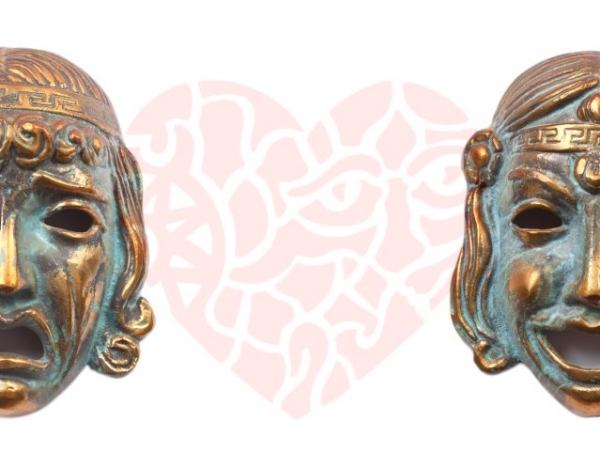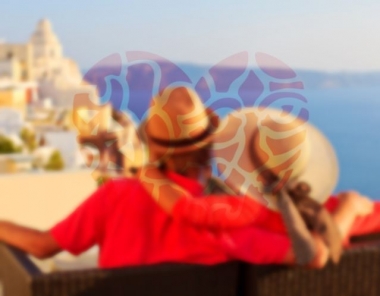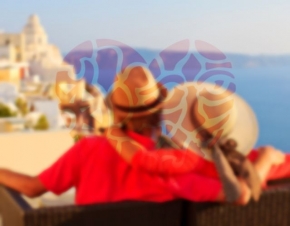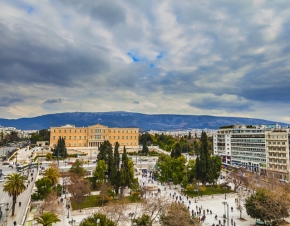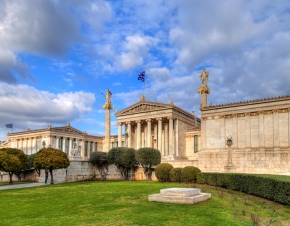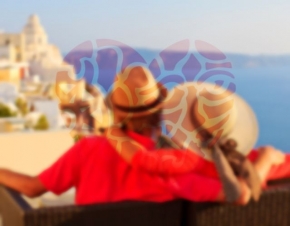The first museum to house the findings from the Acropolis was built in 1874 upon the sacred hill, southeast of the Parthenon. Although the museum was expanded in 1953, its premises were not sufficient to accommodate the findings and so it was decided to build the new Acropolis Museum. Since 2009 that the new Acropolis Museum was inaugurated, the Old Acropolis Museum ceased to operate.
If you love theater and want to watch as many performances as possible, in Athens you will find a small theatrical paradise.
Besides, the city that gave birth to theater and ancient tragedy has a glorious heritage that defends worthily. In Athens there are more than 100 theaters and theatrical stages that every year present all kinds of shows.
A key pillar in the theatrical world of Athens is the National Theatre (www.nt.gr). The National Theatre counts already a century of life and since its first day it aimed to promote intellectual cultivation through the art of theater. With excellent productions in Athens, throughout Greece and abroad, the National Theatre caters for the cultivation and dissemination of the theatrical art.
In Athens you will find at least one theatrical performance matching your taste. Sure thing!
Omonia Square is located at the point where most of the main streets of Athens begin (Stadiou, Panepistimiou, Piraeus, etc.).
In the original town plan of Athens, the area of the square was intended to host the palace of King Otto. Since this failed to happen, the building of a church was decided. Yet, not enough money were found eventually, so they finally decided to create a square.
This square was formed in 1846. It was initially called the Palace Square and later Othonos Square. In 1862 it took its current name as Omonia Square. There, the two dominant political parties of the era swore concord (=omonia) and were reconciled after a series of bloody attacks.
Over the years the square has changed many times look and shape. In its center occasionally fountains, plants and statues have been found. In the first half of the 20th century, Omonia Square was the meeting place for residents of the province who came for the first time to Athens.
The heavy traffic coupled with the gradual degradation of the area, made Omonia Square lose the square-character it once had and now it looks more like a crossroad and transport hub.
In front of the Greek Parliament, right in the heart of Athens, you will find Syntagma Square, which together with Omonia Square are the main squares of Athens.
It was originally called the Palace Square, as the building that now houses the Greek Parliament, was once the Old Palace and residence of King Otto. After the Revolution of the 3rd September 1843, when the army and the citizens gathered in the square together, forcing Otto to grant them a constitution, the square changed name to Syntagma (=Constitution) Square.
Around the square you will find some of the top hotels in Athens, while the square is a hub for public transport with trolley bus stops, buses and subway station. Therefore, it is no surprise that the meeting point for Athenians coming from different areas is Syntagma, as this is how Syntagma Square is called for short.
Three of the most beautiful buildings in Athens are located a few meters from Syntagma Square, in Panepistimiou Street. The University of Athens, the Athens Academy and the National Library are also called "Neoclassical Trilogy of Athens". The Academy and the Library are works of the famous Danish architect Theophil Hansen, while the third, the University, is also a work by the Hansen family, as it is his brother, Christian, who was responsible for it.
Although these three buildings were designed and situated almost at the same time, they were not built together, probably for economic reasons.
The University of Athens preceded the rest. The main building of the University was founded in 1839 and by 1842 had its front wing complete. The rest of the building was gradually complete until 1864.
Following on, the Athens Academy was founded in 1859 and completed in 1885. The building is Ionic and upon its two tallest columns on either side of the building, there are the statues of Athena and Apollo.
Last but surely not least, the National Library was founded in 1887 and completed in 1902, thus creating the trilogy envisioned by Hansen.
Even today, the three buildings that make up the Neoclassical Trilogy still shake visitors with their beauty and still among the most photographed locations in Athens.
The Monastery of Daphni is in Haidari, 11 km from the city center towards Eleusina.
In the premises of Daphni Monastery, the church of Dafneiou Apollo predated. It was right upon the ancient engraving of the Sacred Road that connected Athens and Eleusina, and thereby gave its name to the area. The new church was built in 5 AD, upon the ruins of the old temple, as the Christians used to. Actually, one of the temple's columns was used as a column in the new church that stands tall up until the present day.
In 1205, the monastery was plundered by the Crusaders and ceded to French monks. These were later expelled by the Turks and the Daphni Monastery was granted again to Greek Orthodox monks, but unfortunately was gradually deserted. The restoration work began in 1900, while the Daphni Monastery suffered several losses from the great earthquake in Athens in 1999.
The Daphni Monastery is a typical Byzantine monument and is distinguished by its unique architecture and unique mosaic decoration. All these elements contributed to the decision in 1990 that Daphni Monastery ought to be protected by UNESCO as a Monument of Cultural Heritage.


